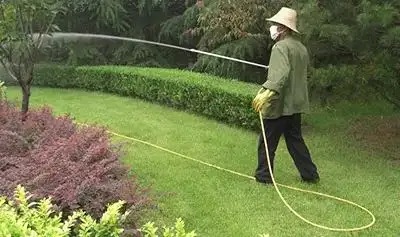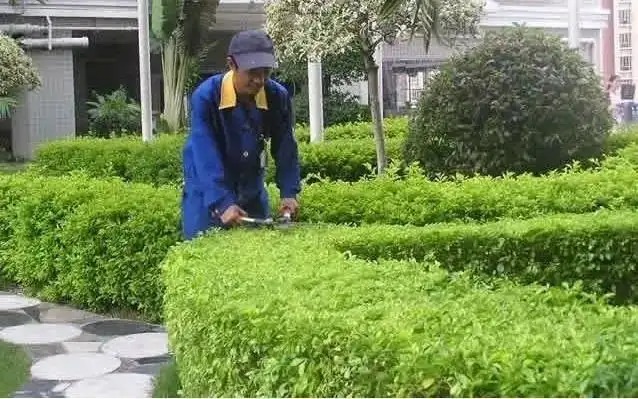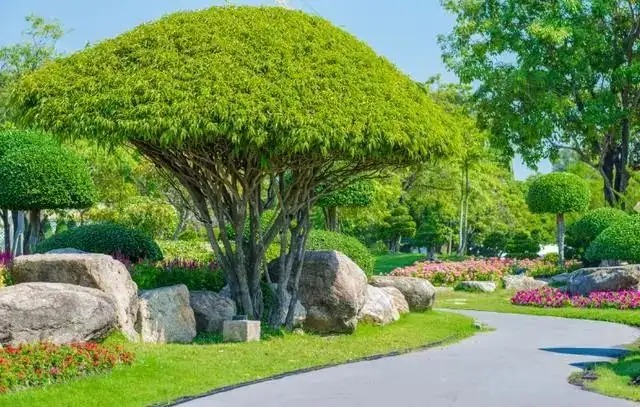Essential knowledge for landscaping maintenance
Landscaping should be seen everywhere in our lives. Whether we enter a city or enter the community where we live, it is the landscaping plants that bring us fresh air and happiness.
We know that maintenance and management in the later stage of transplanting seedlings is very important. The survival rate and later growth of a seedling are only 30% related to the planting technology, but the later maintenance and management account for 70%. This is the so-called "three parts planting, seven parts maintenance". So how should the landscaping be maintained?

01
Basic knowledge of landscaping maintenance:
1. Watering
Newly planted seedlings should be watered immediately after planting to establish roots. For trees and single shrubs, a hose should be inserted from multiple directions around the planting hole to irrigate the area with water until water comes out. Spray the branches and leaves to keep them moist after each root watering.

2. Clear garbage and stones
A comprehensive inspection should be conducted every day to clean up all garbage, stones, fallen leaves, etc. in the responsible area. After collection, they should be placed in a hidden place in the wall at the entrance to the garden, and be sure to arrange them neatly.
3. Pull out weeds
Pulling out wild weeds should be done continuously, and weeding should be done early and in a small way, which will save labor and effort and achieve good results. The weeds that have been pulled out should be put away before leaving get off work every day, and random throwing is strictly prohibited. When weeding, be sure to pull out the weeds by the roots. Some weeds with deep roots can be dug out with tools such as a small hoe.
4. Fertilization
Fertilizer application: Mix urea and compound fertilizer in a ratio of 1:5 and spread evenly on the roots of the seedlings. After spreading, use a broom to clean the fertilizer left on the leaves of the seedlings to prevent the fertilizer from burning the leaves. Water in time after fertilization until the fertilizer is basically dissolved.
5. Pruning
Prune in time according to the growth habits, flowering and fruiting habits, and pruning purposes of the seedlings to maintain the plant shape. The cut branches and leaves should be collected and put away in time, and they are not allowed to remain on the seedlings. In addition, pay attention to pruning as little as possible when the plant is about to bloom or during the flowering period to avoid affecting the green landscape. For fast-growing plants such as azaleas and red flowers, the number of pruning should be increased.

6. Loosening the soil
Depending on the compaction of the soil, regularly use a small hoe or rake to loosen the soil for the seedlings (including trees and shrubs) to ensure the absorption of nutrients and water. The tillage depth is about 5CM, which should not damage the root system of the seedlings.
7. Prune dead branches and leaves
Patrol the area you are responsible for 2-3 times a week and remove dead branches and leaves from various seedlings in a timely manner. Use high-branch shears to cut off dead branches on taller trees.
02
Four-season landscaping maintenance plan:
1. Spring (March to May)
1. Fertilization: Fertilize the green belts and trees by applying thin fertilizers frequently. Use compound fertilizer mixed with nitrogen fertilizer, and spray foliar fertilizer in sunny weather.
2. Prevention and control of pests and diseases: As the temperature rises, focus on preventing and controlling pests and diseases by spraying a mixture of insecticides and fungicides on plants.
3. Pruning: Prune and shape hedges and trees, with an emphasis on pruning overgrown branches and branches with diseases and insects.
4. Watering: Water the plants appropriately and keep the soil moist.
5. Weeding: Remove weeds in the green belt.
2. Summer (June to August)
1. Watering: Focus on drought resistance and seedling protection. Use the method of watering in the morning and evening to stagger watering. When there is too much rain, strengthen drainage to prevent waterlogging.
2. Fertilization: A small amount of fertilizer can be sprayed on the seedlings.
3. Prevention and control of diseases and pests: mainly prevent and control the occurrence of foliar diseases and pests, and spray pesticides in a targeted manner.
4. To protect plants from the sun, mainly install sunshade nets.

Autumn (September-November)
1. Pruning: Prune and shape the hedges. For trees, focus on removing diseased and insect-infested branches, overgrown branches, and overcrowded branches.
2. Fertilization: Fertilize the green belts and trees. Use compound fertilizer mixed with phosphorus and potassium fertilizer.
3. Watering: Check the soil moisture and water at the appropriate time.
4. Inter-row cultivation and loosening of the soil: Inter-row cultivation and loosening of the soil can improve soil looseness and promote the growth of plant roots.
5. Pest and disease control: spray pesticides against autumn pests and diseases, mainly to control scale insects, leaf blight, and red spiders.
4. Winter (December to February)
1. Pruning: Perform winter shaping and pruning. Remove diseased and insect-infested branches, overgrown branches, overcrowded branches, and dead branches.
2. Fertilization: Winter fertilizer should be applied deeply and sufficiently to improve the soil. Fertilizer should be a combination of compound fertilizer and organic fertilizer.
3. Prevention and control of diseases and pests: focus on the prevention and control of overwintering pests and whitewashing the trees for protection.
4. Cold protection: Protect some plants from cold and set up a cold-proof shed.
Source: Clean Bar